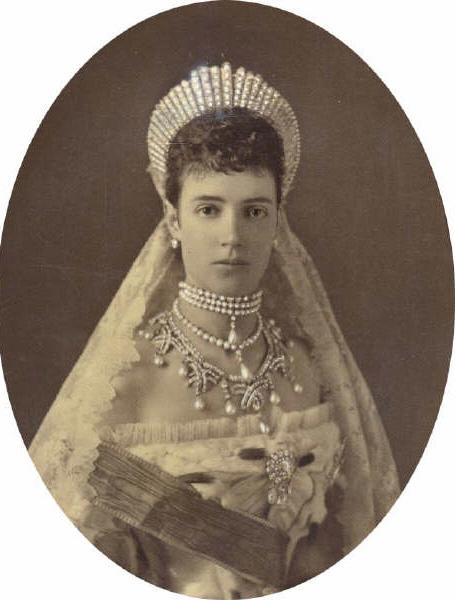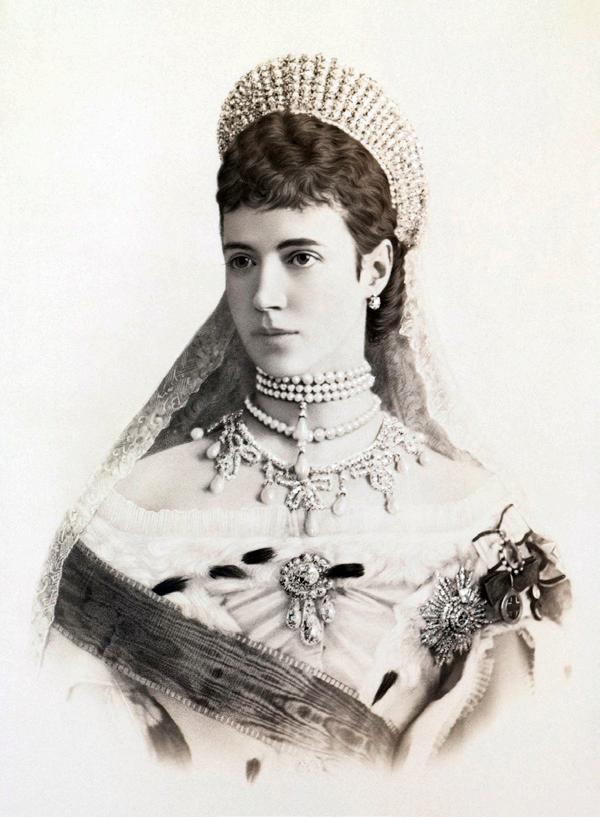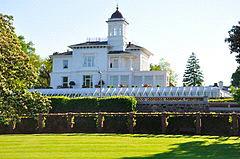
14 minute read
Lady of Tears
by Annette Lind
With the unrest in the country, Alexander and Dagmar moved about 31 miles outside of St. Petersburg to Garchina Palace. This large palace had been built by Catherine the Great, and it had over 900 rooms. They lived there for 13 years with their five surviving children. They were always under heavy guard, but in the summers they were able to visit Denmark. These trips were especially enjoyable since in Denmark they had so much more freedom. In 1887 a plot to assassinate Alexander III was launched. Those involved hollowed out books and filled them with dynamite to throw at the Czar The Okhrana discovered the plot. Five students were hung. One of them was the older brother of Vladimir Lenin. The oldest son of Dagmar and Alexander II, Nicholas, was a bit of a playboy. His parents thought it was important that he marry, but the woman he wanted to marry was Princess Alicky, a grandchild of Queen Victoria. Both Dagmar and her husband felt the young woman did not have the right character to be an empress. However by July of 1894 it was very apparent that Czar Alexander III was very ill. The parents relented. On March 1, 1894 the Czar died. He was only 49 years old. Dagmar had lost her Sasha as he was known to the family. Around a week later the Nicholas and Alicky were married. The Empress was now the Dowager Empress, but while she had not been much involved in politics as Empress, she now became very involved. She served as a political advisor to her son. The young Czar would often check with his mother before making decisions. Dagmar pressed him to resume the reforms his grandfather had begun in order to avoid revolution. However when after four daughters Alicky, now Empress Alexandra, gave birth to a son, she replaced Dagmar as her husband’s advisor. The two women were opposites. Dagmar had worked to ingratiate herself to the Russian people. Empress Alexandra was shy and closed herself off from the people. Dagmar was especially interested in removing Rasputin, a mystic and faith healer, who had become a part of the Russian court. However, Rasputin had the ear of the Empress who believed he had saved her son’s life. (Alexis Nicholaievitch suffered from hemophilia and when he was extremely ill, Alexandra had contacted Rasputin who told her the boy would recover. The next day he started getting better.) As a result, she fought the attempts by Dagmar to have him removed. The tensions grew between Dagmar and her son and daughter-in-law to the point they no longer had contact. Dagmar began to spend more time outside of Russia on trips to Denmark and England. She and her sister Alexandra purchased the villa Hvidøre just north of Copenhagen. She continued to try to influence her son from a distance but it became clear the Empress Alexandra was actually calling the shots in Russia. Dagmar moved to Kiev. In 1914, Russia was drawn into World War I, but was unprepared for the scale and magnitude of the fighting. Nicholas’ subjects were horrified by the number of casualties the country sustained. Russia had the largest number of deaths in the war—over 1.8 million military deaths, and about 1.5 million civilian deaths. Dagmar was in England when Russia entered the war. She tired to hurry home but was stopped by the German authorities from entering Russia. She had to go through Denmark and Finland. Once back in Russia she again worked on the war effort as President of the Red Cross. In 1917 the Russian Revolution began. On March 15, 1917, the army garrison at Petrograd joined striking workers in demanding socialist reforms, and Czar Nicholas II was forced to abdicate. He first abdicated in favor of his son Alexis. But his son was ill and weak and Nicholas then abdicated in favor of his brother Michael. However, in light of the circumstances, Michael did not accept the authority. After 304 years of Romanov rule in Russia, the dynasty was finished. Dagmar was shocked. She left Kiev to meet with her son. They spent three difficult days together. On March 21 they bid each other what
Advertisement
was to be the final goodbye. She never saw Nicholas again. With the government of Russia in chaos, it became necessary that Dagmar leave Kiev. The Kiev Council made it plain that she was no longer welcome there. In the beginning of April 1917 Dagmar and some of her family were ordered to leave for the Crimea. It was a frightening journey. After arriving in Crimea, she lived in Ai-Todor. Most communication between Dagmar and her family was now cut off. At first they were mostly left alone, but in May the house was searched and the family put under arrest. They were afterward confined to the estate and no letters could be sent or received. Eventually paths of communication were opened, and Dagmar was no longer under arrest. But in August she learned Nicholas and his family had been moved to Tobolsk in Siberia. The situation was deteriorating and offers came from many countries to help Dagmar escape and seek asylum with them. She always refused. Lenin and the Bolsheviks were now in charge. On March 1918 Russia signed a peace treaty with Germany. Lenin was anxious to be out of the war and turned over a lot of Russian territory to the former enemy. On March 11 Dagmar was forced to move to Djulber. They were guarded by over 60 men with machine guns. Food was strictly rationed. Pleas were sent by family and friends of Dagmar to her sister Alexandra saying Dagmar’s situation was critical.
The Germans were marching toward the Crimea and rumors circulated that there were plans by the Bolsheviks to eliminate the Romanovs so they could not be saved by the Kaiser. Again arrangements were made to try to rescue Dagmar and her family. But Dagmar was saved when a German column sent by the Kaiser arrived in Crimea. She was saved by Russia’s enemies and for much of her life, her enemies as well. Dagmar, however, refused the offer of asylum in Germany and instead asked to be guarded not by the German army but by the local Tartars who lived in Crimea and had remained loyal to Russian Dowager Empress. In April, Dagmar moved again, this time to Harax located just west of Ai-Todor. Life for the Romanovs in the Crimea returned to a semblance of order. For Dagmar, however, one thing became more difficult. No one had heard from Nicholas and his family since March when they were sent to Tobolik. By July life for Dagmar was unbearable without knowing where her son and grandchildren were. Then on August 1, 1918 she heard Nicholas had been shot sometime in the middle of July but that the Empress and children were safe. On November 11, 1918 Germany lost World War I. They had to evacuate from Crimea. More attempts were made to convince Dagmar to leave and return to Denmark or Sweden or even Germany. Dagmar rejected any plan for her to leave secretly. In fact, she refused to leave unless she was attacked. In January 1919 Dagmar made another of the several attempts she had previously made to find out what had happened to her son Nicholas and his family. She learned nothing more. In fact, however, in July of 1918 the advance of counter-revolutionary forces caused the Yekaterinburg Soviet forces to fear that Nicholas might be rescued. After a secret meeting, a death sentence was passed on the imperial family, and Nicholas, his wife, his children, and several of their servants were gunned down on the night of July 16. Dagmar refused to believe her son and his family were dead and kept her faith until her death in 1928. However, her daughter Olga has written that she thought Dagmar, in her heart, knew they were dead. The Red Army moved closer and closer to Crimea with Dagmar insisting it was her duty to remain. In early April of 1919 Captain Charles Johnson of the battleship H.M.S. Marlborough arrived in the harbor near Harax. He brought an offer of asylum from King George of England and a letter from Alexandra begging Dagmar to leave. After several hours of persuasion, she finally admitted defeat, but only if others could also come. In the end the ship carried 19 members of the Imperial family along with their maids, manservants, governesses and officials of their households. In addition there were 1,170 crew, 200 tons of luggage and a fortune in jewels. The result was the ship had to be outfitted for many many more people than originally planned. Before she left Dagmar insisted she go to

pray at a small church at Harax, even though the Red Army forces were in the area. On April 11, 1919 Dagmar finally left Russia. She had lived 52 years of her life there. Her husband and two sons were buried there and her children Olga and Michael and even Nicholas (or so she believed) remained behind. It is said as the ship moved into the Black Sea, Dagmar “stood on deck, watching the coastline until she could see it no more. She had lost her country, possessions and many of her family but she had her life. Now at seventy-one, she would spend the rest of her life in exile” (quote from page 320 of Coryne Hall’s book Little Mother of Russia). Dagmar arrived in England on May 9, 1919. Unlike the arrivals that had greeted her in the past, it was apparent to Dagmar that now she was just one more of the many Royals who were now exiles. Although finally back with her beloved sister, the two women found little in common after all the years that had passed. It is often written that Dagmar had a hard time no longer being the most important woman in the room. By August things had reached a point at which Dagmar decided to return to Denmark. She is quoted as having said, “Better number one at Hvidøre than number two at Sandringham. (Sandringham is a country retreat and private home used by British monarchs since 1862).

Hividøre Originally a home was built by King John of Denmark in the 16th century on this site along the Oresund just north of Copenhagen for strategic reasons. It was the only port north of Copenhagen where ships could land. In 1871 the original home was demolished the home that exists today was built. In 1937 the home was purchased by Novo Industry and in 1938 opened as a sanitarium for people with diabetes. Here is where our lodge has a bit a a connection with Dagmar. Many of you probably remember the program presented to our Lodge by member Marian Wilkerson. Marian spoke to us about the Novo Nordisk company, a Danish pharmaceutical company for whom she works. The parent company now owns Dagmar’s home. It is used for internal conferences and training by the Novo Group. In April of 1920 having learned that Olga her daughter and her family were in Belgrade, Dagmar wanted them in Denmark. They arrived on Good Friday that same month and lived with Dagmar at Hvidøre. Dagmar’s presence in Denmark raised some issues for the King and the country. She continued to live as if she were still rich. (At one time it is believed that the Czar was the richest man in the world.) Dagmar's hatred of Germany and angry views on the Russian civil war were an embarrassment to the Danish government who refused to give her financial support. She made several return trips to England and was there on April 26, 1923 to attend the wedding of Albert, Duke of York to lady Elizabeth Bowes-Lyon. The first child of this couple is today Queen Elizabeth II of England. During her stay her sister Alexandra suffered from declining health. Dagmar herself became ill and was forced to spend the entire summer of 1923 in England. During her time in Denmark many of the Romaovs moved to Copenhagen. Most felt that they would not be long in exile and would soon be able to return to Russia and their previous lives. They especially felt this way after the death of Lenin in January 1924. Because Dagmar refused to recognize that her son and his family were dead, there was an unwritten agreement that as long as she lived no member of the Royal family would claim the throne. Grand Duke Cyril Vladimirovitch broke that agreement and proclaimed himself Emperor as soon as Michaelm Dagmar’s son, was declared legally dead in 1924. Dagmar was furious and worked to keep his claim from being recognized by the other Romanovs. Throughout her final years she received reports both confirming the death of Nicholas or supporting the idea that he or at least some of his family still lived. Perhaps one of the most interesting claims was from a young woman who claimed to be Anastasia, daughter of Nicholas and Alexandra. This woman had been pulled from a canal in Berlin after attempting suicide. In the hospital she began to confide in people that she
was, in fact, Anastasia. Some people thought she looked like the Anastasia. It is thought that even Olga, Dagmar’s daughter, thought the girl might be who she said she was. Eventually the girl moved to America and called herself Anna Anderson. When the bodies of nine people were excavated near Ekaterinburg, DNA tests were performed and the scientists determined there was a 98.5% chance that five of them were Nicholas, Alexander and three of their daughters. The other four were thought to be servants. Then ten years after the death of Anna Anderson in 1984 her DNA, gathered during a operation she had in 1979, was compared to that of the Romanovs. It did not match, but it did match the relatives of a woman named Francesca Schanzkowska, a Polish peasant who had disappeared in 1920. On November 20, 1925 Dagmar’s sister Alexandra died of a heart attack. It was one more loss for this woman who had endured great fame but also so many sad losses. Her daughter Olga said after this news Dagmar began to look and act like an old woman. By October of 1928 she was failing fast. At 7:00 p.m. on Saturday, October 13, 1928 Dagmar died. She had slipped into a coma and died peacefully. Her daughter said it was one of her last wishes to be placed next to her husband, Alexander III in Russia, if it was ever possible. Christian X of Denmark, who had had to deal with many of the issues involved with having the former Russian Empress in his country, at first said there would not be a state funeral. Public opinion, however, made him change his mind. Her coffin was carried with great pomp and circumstance through the streets of Copenhagen The city’s shop windows were draped in black and flags were lowered to half mast. A special train carried her body to Roskilde where following a service the last surviving Empress of Russia was laid to rest in Frederick V’s chapel. In 1958 Dagmar’s coffin was moved to the private royal crypt on the lower level of the cathedral. In 1997, the 150th anniversary of Dagmar’s birth, a service was held in the crypt. So now we are back to the point at which we started in 2006 when this small woman with the incredible life finally found her place at her husbands side in the country that had become her home. Her son Nicholas and his family are also interred in the St. Peter and Paul Church in Russia where the body of Dagmar now lies next to her beloved Sasha. There are three books in English on Dagmar: The Empress Marie of Russia and Her Times by Vladimir Poliakoff written in her lifetime.

Marie Feodorovna, Empress of Russia by E.E.P. Tisdall in 1957
Little Mother of Russia by Coryne Hall in 1999 (this book was used extensively in writing this article and will be donated to our Sisterhood Lodge library.) There is also a youtube video that can be found at https://youtu.be/IlDaiAWVv64. Click on this site or copy and paste site into your browser. I think you will really like seeing Dronning Margrethe II talk about her ancestor, Dagmar, Princess of Denmark, Empress Marie Feodorovna of Russia.
Membership Expansion
Welcome New Members!
LODGE
300 300 300 300 NEW MEMBER
Alicia Sweeney Nuket Curran Janice Stuerzl Jennifer Tbaxton SPONSOR
Nellie Curran Nellie Curran National Linda Brooks




